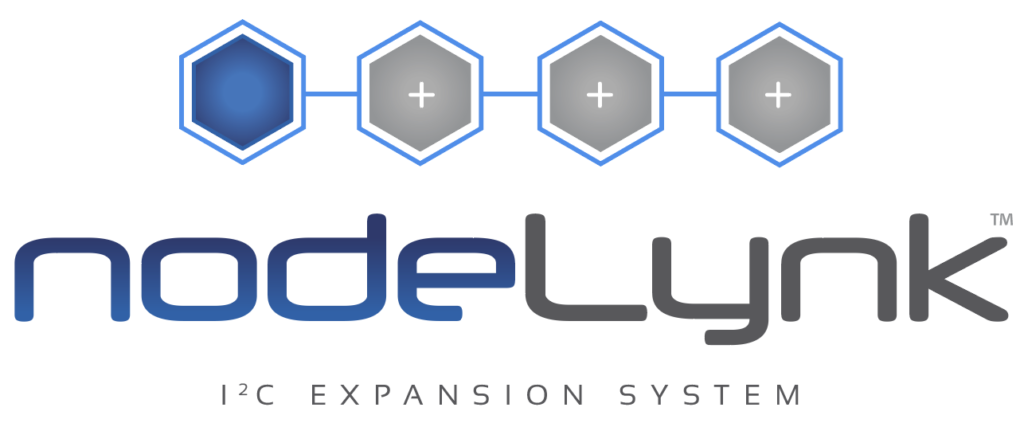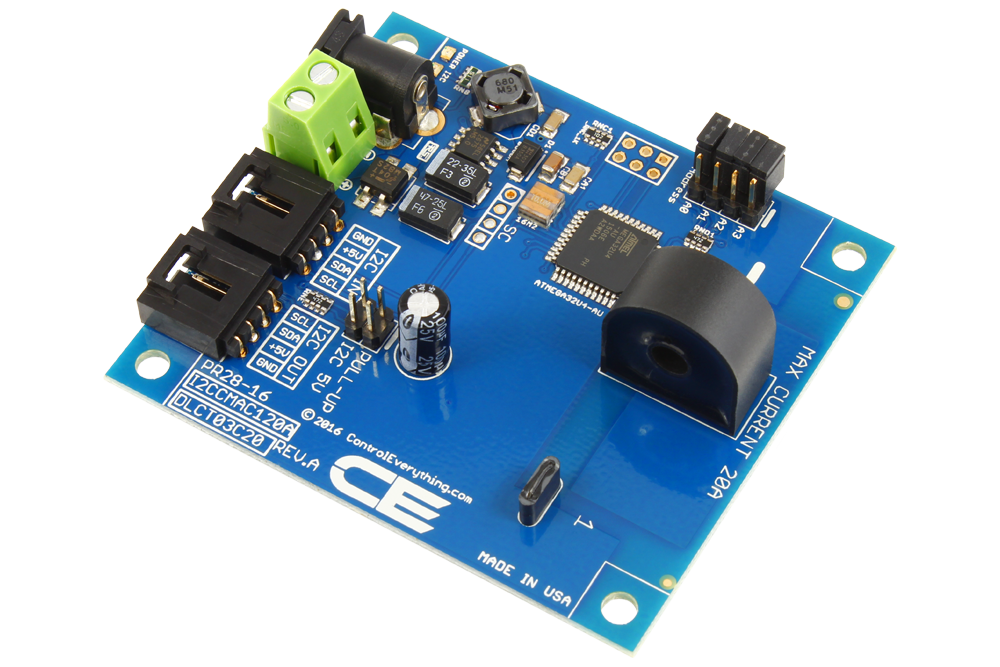1-Channel On-Board 95% Accuracy 20-Amp AC Current Monitor with I2C Interface
Highlights
- I2C Current Monitoring Controller
- Ideal for use with PC using Windows 8/10 via USB
- Compatible with Arduino, Raspberry Pi, Onion, PyCom
- 1-Channel Input with 5, 10, 15, or 20-Amp Input Range
- Solid Core Current Sensor with 5% Max Error Rate
- Cross-Platform Compatible I2C Communications
- On-Board I2C Expansion Port
- Expandable to 16 Devices per I2C Port
- FREE I2C Cable Included
- 0x2A I2C Start Address
Current monitoring of your AC power load is now possible using cross-platform I2C communications, making current monitoring possible for your Raspberry Pi, BeagleBone, Arduino, or any other computing platform that supports I2C. Monitor current and keep track of your power consumption using your favorite computing platform. This controller has one 20-Amp current monitoring channel, precision tuned to monitor the current flow through the on-board current sensor with a 5% maximum error rate. This controller is available for purchase in 5, 10, 15, or 20-Amp input ranges. We suggest choosing a amperage range that properly suits the load you intend to monitor for best accuracy and resolution. To use this device, simply run an AC power wire, up to 10 AWG in size, through the center of the sensor. The on-board custom designed CPU will do the rest using I2C communications.
This controller includes an I2C expansion port, allowing expansion for more current monitoring inputs or other types of I2C sensors and devices. Four on-board address jumpers allow expansion of up to 16 current monitoring devices through the I2C expansion port. Mix and match current monitoring controllers of any size to meet your specific application requirements.
Software developers can take advantage of our ControlEverythingCom GitHub repository for current monitoring and programming samples. This device only requires a 12VDC power supply for operation, which may be plugged into the controller using a 2.1mm center positive barrel connector or on-board terminal block for direct wired power supplies.

nodeLynk™ Device
This is a nodeLynk device, it will require a nodeLynk Master Adapter for proper operation. nodeLynk devices plug into Master microprocessors to easily add hardware sensing and control capabilities.
What is nodeLynk?
Chain expansion devices using nodeLynk. Connect a wide variety of accessories to expand the capabilities of a nodeLynk compatible controller. Use nodeLynk to add Relay Controllers, Sensors, PWM Drivers, Displays, and a wide variety of 4-20mA, 0-10V ADCs and DACs, as well as a wide array of TTL & Isolated GPIO devices. All nodeLynk devices use I2C communications to chain devices together. nodeLynk is an easy way to expand functionality without soldering. nodeLynk allows expansion in seconds so you can focus on your software and firmware development.

What is the nodeLynk I2C Interface?
NCD is the creator of plug and play modular hardware using nodeLynk, which is hardware I2C Interface connector standard. nodeLynk I2C devices allow you to chain together several devices on the I2C bus, and communicate to each device individually at high speed (subject to the limitations of I2C). The nodeLynk I2C Interface uses a standard 4-Pin I2C Input and I2C Output connector. nodeLynk I2C devices communicate 5V I2C data and provides 5V DC power through this connector. nodeLynk I2C devices use standard I2C communications for all data transport, which is supported by nearly every microcontroller in production today. The nodeLynk I2C Interface is strictly a 5V standard, which is ideal for transport across longer cables. nodeLynk I2C devices always include a 6″ (152mm) 4-conductor I2C cable. nodeLynk I2C Mini Modules always include a 3″ (76mm) 4-conductor I2C cable. Cables and connectors are available separately for designers who would like to include their own nodeLynk I2C Interface into their designs.
Plug and Play Connectivity
nodeLynk I2C devices will plug in to any available nodeLynk I2C Output. This includes just about everything we make in the NCD IoT Category, including all NCD IoT devices. We also manufacture a wide range of I2C adapters that make it easy to plug nodeLynk I2C Devices directly into most computing platforms. nodeLynk I2C Interface adapters are available for Arduino, Banana Pi, BeagleBone, Bluz, ESP8266, Onion Omega, Particle Photon and Electron, PyCom, Raspberry Pi, 2, 3, and Zero, and Windows. We are always working to add new platform support for nodeLynk I2C devices. nodeLynk I2C Interface devices are compatible with just about everything in the microcontroller industry.
Unlimited I2C Expansion
Based on our plug-and-play I2C interface standard, all nodeLynk I2C devices are equipped with a I2C output port, making it easy to expand to a wide variety of sensors, current monitors, relay controllers, PWM controllers, and much more! We are always designing new expansions for our modular plug-and-play I2C framework. We are dedicated to building a product line of interconnected devices to simplify all forms of automation. Re-use or upgrade your hardware in seconds by selecting the modules that best fit your needs, and chaining them together using the included I2C expansion cables!

A Raspberry Pi (above) is connected to a nodeLynk Master adapter. nodeLynk devices are chained to the Raspberry Pi nodeLynk Master using I2C communications. Each nodeLynk device must have a different I2C address for proper operation of the chain. Note that some nodeLynk I2C devices have a fixed address while others allow configuration of the address across a limited range of addresses.
Powering nodeLynk I2C Interface Devices
Some nodeLynk I2C devices require a external power supply, others may be powered through the 4-Pin I2C bus connector at 5VDC, and other devices are jumper selectable between external and I2C bus power. All I2C mini modules are powered through the 5V I2C bus connector, greatly simplifying connectivity.
Mechanical Drawing
Wiring Diagrams
Datasheets
Integration Notes
This device is tuned for reading current in the 0 to 20-Amp range. Exceeding 20 Amps through the core sensor may damage the on-board CPU. For best accuracy, we highly recommend choosing a controller with the lowest possible amperage rating required for your application. This device is designed for AC current measurement only and cannot be used to monitor DC loads. This device is typically more accurate than commercially available clamp meters and nearly as accurate as most direct wired meters. This device will arrive pre-set to a calibration value that was known to work well in our master designs. For higher accuracy, users may adjust our recommended calibration settings. All current monitoring controllers require half of a second to analyze and compute a current monitoring result for all channels. For best performance, we suggest communications with this device no more than once per second.
Usage Notes
All NCD current monitoring controllers with on-board current sensors are calibrated for use with resistive loads. They can be re-calibrated for inductive loads, but we do not recommend mixing the two types of loads using the same controller. A mix of resistive and inductive loads may be monitored using NCD current monitoring controllers equipped with external off-board sensors. These controllers include a wire between the main board and the sensor.
Do not attempt to pass more than a single wire through the current sensor. Doing so will cancel the signal and prevent proper operation.
I2C Interface Compatibility
NCD I2C Interface devices are designed to plug in to many popular IoT computing platforms. This allows the “brains” from other manufacturers to directly plug into our devices for easy plug-and-play operation. I2C interface devices use I²C as the underlying communications technology. The notes below will guide you into plugging 3rd party technologies into our devices, we will highlight any adapters that may be required in this section. Please note that all NCD I2C Interface Devices can be chained together to any other Cross-Platform I²C Slave Devices using the I²C Output. Additionally, NCD I2C devices may be plugged into the I2C Output of NCD IoT Interface devices. A complete list NCD I2C Interface adapters is available by clicking here.
Arduino Interface
- Plug this device into the Arduino Micro I2C Shield
- Plug this device into the Arduino Nano I2C Shield
- Plug this device into the Arduino Uno I2C Shield
- Plug this device into the Arduino Due I2C Shield
Banana Pi Interface
- Plug this device into the Banana Pi I2C Shield
BeagleBone Interface
- Plug this device into a BeagleBone I2C Shield
Bluz Bluetooth Interface
- Plug this device into the Bluz I2C Shield (with power)
C.H.I.P. Interface
- Plug this device into the C.H.I.P. I2C Shield
ESP8266 Interface
- Plug this device into the NodeMCU ESP8266 I2C Shield
- Plug this device into the Adafruit Huzzah ESP8266 I2C Shield
Particle Interface
- Plug this device into a Particle Photon WiFi I2C Shield
- Plug this device into a Particle Electron Cellular I2C Shield
Onion Omega 1 & 2 Interface
- Plug this device into a Onion Omega I2C Shield
PyCom Interface
- Plug this device into a PyCom WiPy, WiPy2, and LoPy I2C Shield
Raspberry Pi Interface
- Plug this device into a Raspberry Pi I²C Interface Adapter
- Plug this device into a Raspberry Pi 2/3 I²C Interface Adapter
- Plug this device into a Raspberry Pi Zero I²C Interface Adapter
Windows 8/10 PC USB Interface
- Plug this device into a USB to I2C Converter
- Plug this device into the BridgeX5 Series Controller
Out of stock





















